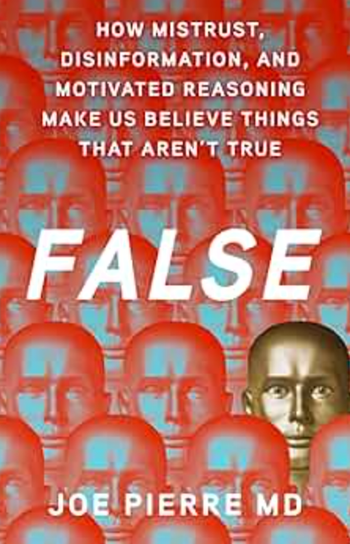
Healing: Our Path From Mental Illness to Mental Health
Thomas Insel, MD’s, book contains several highly valuable lessons for psychiatry and beyond.
BOOK REVIEW
by Thomas Insel, MD
Penguin Press, 2022; 306 pages
Reviewed by Renato D. Alarcón, MD, MPH
Author’s note: All directly quoted phrases throughout the review belong to the book’s text.
One of the most fascinating and complex processes taking place in the mental health field is the almost unanimous recognition of a parallel advancement of both its biological and sociocultural knowledge components in etiopathogenic, diagnostic, clinical, and therapeutic areas. The best evidence of the resulting paradox—stunning scientific progress versus increasing prevalence of mental illnesses and subsequent suffering of the patients and their families—are documents written by individuals close to its occurrence, exceptional witnesses of a gigantic contradiction in progress.
Such is the case in Healing: Our Path From Mental Illness to Mental Health, authored by Thomas Insel, MD, former director of the National Institute of Mental Health (NIMH). The book—based on Insel’s reflections, thoughts, and experiences after his retirement—is a sincere and profound recognition of his own and the US health system’s misunderstanding of “the problem,” as well as an embrace of “a promise” of better future times amid climbing psychopathology statistics, focused on “relieving symptoms and not on helping people recover.” In such context, Healing is both a denunciation and a redemption—a self-reproach and a request.
The introduction of the volume is, indeed, a telling summary of the story evolving in the 3 parts and 12 chapters that follow. Serious mental illness (SMI), which covers many conditions with disability as a common and frequent outcome, configures what Insel calls “an American tragedy” and summarizes as “simply a crisis of care.” The realities we know—and, in fact, many sections of the book—delineate a situation that is far from “simple.” The crisis of care, then, “is not just lack of access but lack of engagement” on the side of patients, families, and even professionals with a variety of “attitudinal barriers.”
I would include here the search for “quick solutions” (ie, pills) dispensed by psychiatrists who, overwhelmed by heavy schedules and persuaded by the active publicity of the pharmaceutical industry and the ambiguous encouragement of a predominantly biological research community, devote no more than 15 minutes to each patient and choose not to talk with patients about relevant family and interpersonal issues.
Historical pieces and well-known names clearly delineate another purpose of the book: to discuss how the different perspectives are guided by political beliefs. Between the 1960s and 70s, Kennedy, Johnson, and Carter worked to increase the federal government’s involvement in the provision of care; in the 80s, however, Reagan slashed federal spending, with the community mental health centers “among the first on the chopping block.”
Insel’s consideration of the impact of his biological school of thought on psychiatric research makes him admit that “we still understand very little about how the brain works.” Nevertheless, he still mentions medications as the first of 4 broad treatment categories to be applied “early in the course of the disease”—the other 3 are psychological therapies, neurotherapeutics, and rehabilitative services. It is encouraging to see rehabilitative treatments described here as a “whole-person care” and “a chance to build or rebuild a life,” which is a critical step to prevent relapses showing “long-term effects that equal or surpass the impact of the medications.”
Part 2, titled “Overcoming the Barriers to Change,”starts with the need to identify 4 stages of progression in the history of a mental condition: (1) the period of risk before the onset of any symptoms; (2) the prodromic period; (3) the acute first episode; and (4) the disability linked to a chronic and pervasive psychosis. There is an absence of treatment for millions of individuals who cannot be identified during the first 2 stages, and access to inpatient care (hospitalization) “is potentially a fatal failure of the care system” for those in stage 3. The deinstitutionalization of the 1980s “created a legal legacy that still today blocks funds for psychiatric hospitalization.”
The resulting tragedy takes the form of another paradox: Jails and prisons become de facto mental hospitals, and state mental hospitals increasingly become de facto jails and prisons, not to count homeless or “people with mental illness sequestered in family basements or living in the urban backwaters of cheap hotels.” America has invested more in prisons than in hospitals. And the book denounces another disgrace: “The nexus of police, mental illness, and violence is fraught with issues: racism, overreaction, and even neglect.”
If “quality is as much of a problem as quantity,” to explain and attempt to understand the mental health care crisis, one factor may be the “little consensus among the various care providers as to how to approach even the most common forms of mental illness.” That a former chief of the world’s highest mental health research institution on the subject makes this kind of statement is a sad and painful confirmation of yet another reality in American psychiatry: the divergence between the routes of science and clinical practice, and the deficiencies of what must supposedly bridge education and training in both fields for the benefit of millions.
The proposed solution is “collaborative care” subjected, however, to pervasive “implementation gaps” practically blocking what Insel calls “compelling scientific evidence.” We will have to agree that “anyone suffering from a mental disorder faces an inadequately trained workforce, fragmentation, and delay of services, poor medical care, and lack of measurement, which preempts accountability.”
The chapter titled “Precision Medicine” opens with a justification-sounding quotation from no other than Bertolt Brecht. A “better diagnosis” is presented as the road to better outcomes that, according to this line of thought, can only be reached through the identification of “molecular markers.” Diagnosis in psychiatry and in the United States has had a name (DSM) for the past 70 years, with 5 editions and 8 versions.
Labeled in the book first as a “simple taxonomy” and then as a “working dictionary,” used indistinctly as “a bible” or “an encyclopedia,” not to mention being “a major source of revenue,” DSM “has created a common language, but much of that language has not been validated by science.” The aversion toward the manual (its “pernicious impact”) is distilled through several paragraphs that reject the use of symptoms, deny “symptom relief” as a valid treatment objective, and charge the diagnostic labels with “creating disorders where none exist.”
It is not surprising that “to identify something deeper than symptoms,” the author proposes 2 approaches (genomics and neuroscience), neither of which “has defined the core problem”; each one, however, “is giving us a new perspective that could create a different way of diagnosing mental illness.” The sad reality is that presently, and for an expected long-lasting future history, none of the genetic/genomic variations found so far can be considered causal—only “risk factors.”
Similarly, the wiring brain maps, the “circuitry” revealed by neuroimaging techniques, “is not synonymous with structure” and, ultimately, “structural studies like the MRI are not useful in the diagnosis of mental illness, probably because it is not the physical map that counts as much as the traffic between brain areas.” However, “the evidence for abnormal brain circuitry is not always consistent or specific…[and]…the concept of circuits…may be an inaccurate metaphor for how the brain actually computes.”
Some readers may approve, but most would feel it strange to question the need of diagnosis because “labels, precise or not, get in the way of recovery…[as]…a label on human suffering pathologizes normal variation and medicalizes human experience.” Let’s not forget that diagnostic systems nowadays include not only DSM or ICD, but also Research Domain Criteria (RDoC), the NIMH proposal that, interestingly, is not mentioned in the book, although the references are obvious.
The seemingly extreme proclaim against diagnosis, however, is contradicted a few paragraphs later with the statement, “I believe that the road to better outcomes will run through better diagnosis,” a system that “needs to strive for precision, allowing each person to get the treatment most likely to work, not for a population but for that person.” At the end of this convoluted elaboration, the text recognizes that “in the push for progress, we are up against more than biology. Negative attitudes about diagnosis and treatment may prove a greater challenge.”
Beyond diagnosis, a redemption-sounding statement is made: “Social determinants such as poverty and life stress are often more important for outcome and unquestionably more actionable.” We have known for a long time that the goal of every treatment modality in a multidisciplinary team approach (which the book does not mention, acknowledging instead “a medical approach to define the problem”) must focus on “social and relational approaches.”
Thus, installed in a clearly social alternative route toward the diagnostic characterization of mental conditions, the book analyzes the ways such conditions are managed by the general population. The most eloquent example is stigmatization (“the biggest problem in mental health”), the colophon of the fear, avoidance, and hyper-emotionality (to be read as hostility) associated with the experience of carrying a mental disorder in oneself or in the family. In turn, the route toward recovery is marked by 3 features (the “3 Ps”) that constitute one of the most relevant parts of the volume: people, place, and purpose. “Recovery,” Insel says, “is not just relief of symptoms; it’s finding connection, sanctuary, and meaning not defined or delimited by mental illness.”
Recovery, indeed, is going beyond a life determined by negative features, whether they are symptoms, neuronal misconnections, or “bad genes.” It is restoration of social links that cannot, and should not, be viewed as a “basic biological need” like the book pretends. To explain loneliness, support, solidarity, attachment, or love as purely biological, brain-related phenomena is an exercise in rigidity, exclusivity, and partiality, far from the integral focus of humanity and humanism. A transcendental summarizing phrase from Insel reads: “I have come to think of mental illness as a medical problem that requires a social solution.”
“Recovery also requires a safe place to live,” and place means availability, acceptance, articulation, warmth, and compassion as well as resources and workable norms. Purpose (the third P) means helping those with mental illness and dealing with its social surroundings and sequelae: “We need to engage people not just on what’s wrong, but on what’s strong.”
The closing section of the book centers on a logical sequence: the way forward. Pragmatic approaches (“simpler solutions”) such as integrated or coordinated specialty care (CSC). Here, Insel makes another courageous admission: When CSC was first proposed at NIMH in 2008, he thought “the idea was boring because these interventions had been around for 3 decades.” His first response to the proponent was, “Where is the innovation? I was still in the mindset that the breakthroughs we needed were high-tech, not high-touch.”
Improvements on the basis of existing resources is a tough challenge, but not an impossible task. Multidisciplinary teamwork, and peer and family members’ incorporation “on a foundation of trust” are valid measures. On the basis of numerous experiences abroad—particularly in low- and middle-income countries (LMICs)—“the practical meaning of democratizing care” evolves into the delivery of quality care. Innovative options like the quest for the “quantified self” by software engineers from Silicon Valley are also enthusiastically described. And a positive use of “doomscrolling, privacy hacking, and toxic positivity” on social media could also begin, based on credible information and “a chance to connect…to close the 60 percent gap between need and care.”
Telepsychiatry and related technological innovations are also mentioned as “providing information, connection, and convenience” to both patients and care providers. Increasingly sophisticated modalities are described, and “unavoidable and yet unresolved ethical and trust issues” are recognized. A more specific discussion of some of them (depersonalization risks, insight deficits, mechanization, and a pervasive and paradoxical sense of loneliness) would have been desirable.
Mental illness prevention and mental health promotion become the culminating stations of this arduous journey. In the former, what predominates is tertiary prevention, which is important for the individuals who are already ill, but clearly insufficient in terms of the numbers of all potentially affected by mental conditions. The book assumes a positive position: Anyone could become exposed to triggering factors of mental illnesses; therefore “some of the skills learned in psychotherapy, like mindfulness, reframing, and emotional regulation, not only treat [posttraumatic stress disorder] (PTSD) and depression but could potentially help anyone. Why not teach them to everyone?...Why not try for herd immunity against depression and suicide?”
Mental health promotion is a broader, more complex aspect of healing that is not specifically dealt with in the book. It covers political, legislative, administrative, and sociocultural territories that are theoretically implied and only mentioned as components of its main objective. It is not just the quality of care that matters: “Outcomes are worse because of the world outside of health care. It’s our housing crisis, our poverty crisis, our racial crisis, our increasing social disparities that weigh heaviest on those with the greatest needs.”
Insel also writes that “mental health has become a measure of the soul of our nation.” The undisputable meaning of this phrase is a true reflection of current realities in America and the world. Insel cites Don Berwick’s concept of “moral determinants of health” to deepen the analysis of the origins of the crisis. The mental health crisis is more than a medical challenge: “It is a social justice issue” whose seriousness is compared with the “separate and unequal” Jim Crow phase of American history.
The salience of sociocultural forces in health and sickness, and in medicine, has been recognized throughout different periods in the history of our discipline. Interestingly, Healing uses the words “culture” and “cultural factors” just a few times. Like many others, perhaps Insel considers “social” and “cultural” as synonyms, although they are not: Social entails a broader territory, closer to notions and concepts of public health and collective impact, while cultural encompasses unique features engendered throughout the history, traditions, language, arts, and religions of human groups across the world.
In short, Healing contains several highly valuable lessons. It shows us the perceptual, cognitive, and emotional evolvements of a figure of American psychiatry who led the strongest biological period of research with passion and conviction, promoting and defending it with tools of scientific work and doctrine-guided strategies. More recently, he has utilized such experience as both an echo chamber of self-questioning and a source of needed answers. This process may have been painful at times, but its results can be saluted with respect and renewed hope.
He discovered truths that others had written about but felt compelled to share them through printed evidence. The book becomes, then, a powerful self-revealing essay, an eloquent documentation of personal reflections, a catalog of clinical and social realities, and an agenda for a collective journey that started many decades ago and that COVID-19—among other factors—has dramatically brought to the forefront.
Dr Alarcón is emeritus professor of psychiatry at Mayo Clinic School of Medicine in Rochester, Minnesota; Honorio Delgado Chair at Universidad Peruana Cayetano Heredia in Lima, Perú; and a member of the Editorial Board of Psychiatric Times™.
Newsletter
Receive trusted psychiatric news, expert analysis, and clinical insights — subscribe today to support your practice and your patients.

















